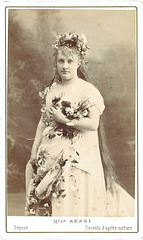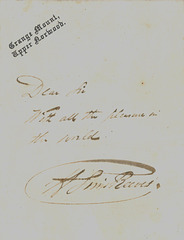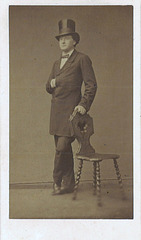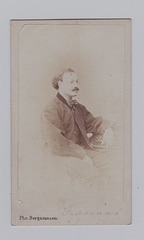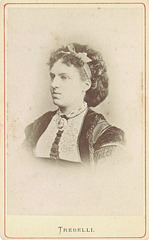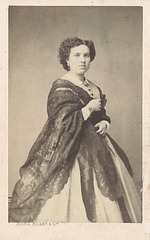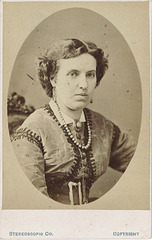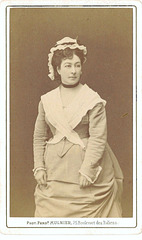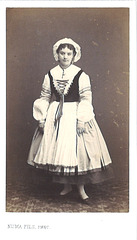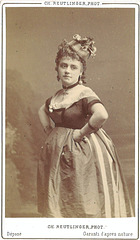
19th century opera singers
Mathilde Sessi by Reutlinger (2)
| |
|
Mathilde Gabriele Sessi, born Alexander (1846-1934); Austrian soprano.
She was descended from the Sessi-family of famous operasingers (the 5 Sessi sisters Marianna, Impératrice, Anna Maria, Victoria and Carolina). Although her birth name was Alexander, for the stage she used the name Sessi.
She started her career in Vienna and then got engagements in Berlin, Frankfurt and Brussels.In 1870 she had her debut in London at Covent Garden as Lucia in “Lucia di Lammermoor” and in that same year in Paris, at La Salle Ventadour, as Alina in Donizetti’s “Alina, Regina di Golconda”. She sang several seasons at Covent Garden and her most famous rôles were Zerlina in “Don Giovanni”, Marguerite in “Faust”, Marie in “La fille du regiment”, Ophélie in “Hamlet”, Violetta in “La Traviata”, the Countess in “Le nozze di Figaro”, the Queen of the Nigt in “Die Zauberflöte”, Marzelline in “Fidelio” and Cecilia in “Il Guarany”.
She married Baron Ludwig von Erlanger (of Frankfort), uncle of Baron Frederick d’Erlanger (the composer). She had a rather short career because after her marriage she soon retired from the stage.
Mathilde Sessi by Reutlinger (3)
| |
|
Mathilde Gabriele Sessi, born Alexander (1846-1934); Austrian soprano.
She was descended from the Sessi-family of famous operasingers (the 5 Sessi sisters Marianna, Impératrice, Anna Maria, Victoria and Carolina). Although her birth name was Alexander, for the stage she used the name Sessi.
She started her career in Vienna and then got engagements in Berlin, Frankfurt and Brussels.In 1870 she had her debut in London at Covent Garden as Lucia in “Lucia di Lammermoor” and in that same year in Paris, at La Salle Ventadour, as Alina in Donizetti’s “Alina, Regina di Golconda”. She sang several seasons at Covent Garden and her most famous rôles were Zerlina in “Don Giovanni”, Marguerite in “Faust”, Marie in “La fille du regiment”, Ophélie in “Hamlet”, Violetta in “La Traviata”, the Countess in “Le nozze di Figaro”, the Queen of the Nigt in “Die Zauberflöte”, Marzelline in “Fidelio” and Cecilia in “Il Guarany”.
She married Baron Ludwig von Erlanger (of Frankfort), uncle of Baron Frederick d’Erlanger (the composer). She had a rather short career because after her marriage she soon retired from the stage.
On the photo she is seen as Ophélie in "Hamlet" by Ambroise Thomas.
Mathilde Sessi by Reutlinger (4)
| |
|
Mathilde Gabriele Sessi, born Alexander (1846-1934); Austrian soprano.
She was descended from the Sessi-family of famous operasingers (the 5 Sessi sisters Marianna, Impératrice, Anna Maria, Victoria and Carolina). Although her birth name was Alexander, for the stage she used the name Sessi.
She started her career in Vienna and then got engagements in Berlin, Frankfurt and Brussels.In 1870 she had her debut in London at Covent Garden as Lucia in “Lucia di Lammermoor” and in that same year in Paris, at La Salle Ventadour, as Alina in Donizetti’s “Alina, Regina di Golconda”. She sang several seasons at Covent Garden and her most famous rôles were Zerlina in “Don Giovanni”, Marguerite in “Faust”, Marie in “La fille du regiment”, Ophélie in “Hamlet”, Violetta in “La Traviata”, the Countess in “Le nozze di Figaro”, the Queen of the Nigt in “Die Zauberflöte”, Marzelline in “Fidelio” and Cecilia in “Il Guarany”.
She married Baron Ludwig von Erlanger (of Frankfort), uncle of Baron Frederick d’Erlanger (the composer). She had a rather short career because after her marriage she soon retired from the stage.
On the photo she is seen as Lucia in Donizetti's "Lucia di Lammermoor".
John Sims Reeves by Fry
| |
|
John Sims Reeves (1821-1900); English tenor.
In 1838 he made his debut (as a baritone) in Newcastle in the opera “Guy Mannering”. From 1841-1843 he was singing minor rôles at the London Drury Lane Theatre, but he continued his studies and his voice turned into a tenor. In 1846 he made a guest appearance at La Scala in Milan as Edgardo in “Lucia di Lammermoor”, a rôle he repeated in London in 1847 with great success. Also in 1847 he sang at the première of Balfe’s opera “The maid of honour”. In 1863 he created the rôle of Faust in the first English sung version of Gounod’s eponymous opera. In the last part of his career he was mainly active as a ballad and oratorio singer.
He published his life story in 1881 in the book “S. Reeves.His life and recollections”.
Autograph John Sims Reeves
| |
|
A short note written and signed by Sims Reeves from his domicile Grange Mount, Upper Norwood.
John Sims Reeves by Thrupp
| |
|
John Sims Reeves (1821-1900); English tenor.
In 1838 he made his debut (as a baritone) in Newcastle in the opera “Guy Mannering”. From 1841-1843 he was singing minor rôles at the London Drury Lane Theatre, but he continued his studies and his voice turned into a tenor. In 1846 he made a guest appearance at La Scala in Milan as Edgardo in “Lucia di Lammermoor”, a rôle he repeated in London in 1847 with great success. Also in 1847 he sang at the première of Balfe’s opera “The maid of honour”. In 1863 he created the rôle of Faust in the first English sung version of Gounod’s eponymous opera. In the last part of his career he was mainly active as a ballad and oratorio singer.
He published his life story in 1881 in the book “S. Reeves.His life and recollections”.
Joseph Dufresne by Petit & Trinquart
| |
|
Joseph Dufresne (Dufrêne); French tenor. After starting his career in Lyon he made his debut in 1851 at the Opéra-Comique creating the rôle of Gaston de Rochambeau in Limnander’s opera “Le Château de la Barbe-Bleue”. In 1859 he was engaged by the Grand-Opéra Paris. He was a member of the “Société des Concerts de Conservatoire” since 1859.
The composer Hector Berlioz was present at the première of “Le Château de la Barbe-Bleue” and he wrote in his feuilleton of 13 december 1851 about the debut of Dufresne as follows:
"Quant à Dufresne, je crois qu’il faut féliciter M. Perrin de l’avoir engagé. Sa voix est un ténor, un peu blanc, si l’on veut, mais qui a du charme, assez de force et de la flexibilité. Pour l’Opéra-Comique enfin c’est un ténor ! Dufresne a d’ailleurs de l’intelligence dramatique, de la chaleur, et ne manque pas d’aplomb musical. Je l’engage seulement à se méfier de quelques unes des notes hautes de sa voix, elles tendent à monter.Le succès du Château de la Barbe-Bleue a été brillant ; tout fait croire qu’il fournira une longue carrière".
Francesco Graziani by Bergamasco
| |
|
Francesco Graziani (1828-1901); Italian baritone who created the role of Don Carlo in Verdi's "La forza del destino" in St. Peterburg (1862). He was born into a musical family. Three of his brothers (tenor Lodovico 1820-1885, baritone Vincenzo 1836-1906 and bass Giuseppe 1819-1905) also became professional singers. His brother Lodovico was the first Alfredo in Verdi's La Traviata in1853. They all studied with Cellini and in 1851 Francesco made his debut in Ascoli Piceno as Conte di Vergy in Donizetti's "Gemma di Vergy". In the following years he performed in all the major opera houses in Italy including La Scala Milan. In 1854 he made a tour of guest appearances through the USA. In 1855 he made his Covent Garden debut in London as Don Carlo in Verdi's "Ernani". Until 1880 he returned to London almost every year and he performed in a number of English premières : in 1855 as Count di Luna in "Il Trovatore", in 1865 as Nelusco in "L'Africaine", in 1867 as Rodrigo in "Don Carlos" and in 1876 as Amonasro in "Aida". During the seasons 1853/61 he was also very successful in Paris at the Théâtre-Italien. In 1862 he created at St. Petersburg the role of Don Carlo in Verdi's "La forza del destino" with Enrico Tamberlick in the role of Don Alvaro. Graziani had one of the most beautiful baritone voices of his time, but from artistic point of view he appears not to have been very gifted. Critics of that time repeatedly referred to defects in his phrasing and they also doubted his musicality.
Enrico Tamberlick by Photographie Artistique de Dr…
| |
|
Enrico Tamberlick (1820-1889); Italian tenor who created the role of Don Alvaro in Verdi's "La forza del destino" in St. Petersburg (1862).
Enrico Tamberlick, who flourished during the middle of the 19th century was a tenor of high rank. He belonged to the class of "tenore di forza" and used to make a tremendous effect with his high C, which he produced with immense power. His voice was one of great richness of tone and volume. His delivery was grand and noble, his phrasing perfect and he sang with a great depht of expression. His elocution was so fine that every word was delivered with full effect and his dramatic power was unusually great. He was seen to best advantage in heroic parts, in which his fine figure and majestic bearing, together with the power and resonance of his voice, were displayed. Such parts as Jean de Leyde in "Le Prophète", Arnold in "Guillaume Tell", Manrico in "Il Trovatore", Otello in Rossini's "Otello", Pollione in "Norma", Poliuto in "Les Martyrs" and Robert in "Robert le Diable".
In 1841 he made his debut at the Teatro Fondo in Naples as Tybalt in Bellini’s "I Capuleti ed i Montecchi" under the name of Enrico Danieli (his mother's name). The following two years he continued his career in Naples at the Teatro Fondo and at the Teatro San Carlo (under the name of Tamberlick). His voice was not yet develloped into the tenor it would become later. From 1843 on he performed in Spain ( Madrid, Barcelona etc.) and Portugal (Lisbon). In 1850 he appeared in London and made his Covent Garden debut as Masaniello in Auber’s "La Muette de Portici". He became so great a favourite that he was engaged there every season until 1864, with the exception of the season 1857/58 when he was engaged at the Théâtre-Italien in Paris. Of equal importance during the years 1850/63 was St. Petersburg (the Mariinsky Theatre) where he made guest guest appearances. Here he created the role of Don Alvaro in Verdi's "La forza del destino" on 10 November 1862. He made his initial guest appearance at the Théâtre-Italien in Paris in 1858, returning there many times until 1877. In 1874 he made a tour of the USA and he was the first tenor of importance who visited South America, singing at Rio de Janeiro, Buenos Ayres and Montevideo. He performed Alfredo in "La Traviata" -with Sofia Vera Lorini as Violetta- for the opening of the original Teatro Colón opera house in Buenos Aires in 1857. He retired from the stage with a tour through Spain in 1881, but he continued giving occasional concerts.
Zélia Trebelli by Pierson
| |
|
Zélia Trebelli, born Gloria Caroline Le Bert (1838-1892); French mezzo-soprano.
She made her debut in 1859 in Madrid as Azucena in “Il Trovatore”. In 1860-1861 she performed in Germany, mainly at the “Berliner Hofoper”. In the years thereafter she had engagements in France (Théâtre-Italien) and in England (Drury Lane Theatre and Covent Garden). She made guest appearances at the Stockholm Opera (1875-1880), at the “Hofoper Wien” (1877-1878), at Berlin, Prag, Düsseldorf, Basel, Budapest, Brussels, Amsterdam and Rome. She made also several tours in the U.S.A. She retired from the stage in 1888. For some years she was married to the tenor Alessandro Bettini (1821-1898).
Zélia Trebelli by Numa Blanc
| |
|
Zélia Trebelli, born Gloria Caroline Le Bert (1838-1892); French mezzo-soprano.
She made her debut in 1859 in Madrid as Azucena in “Il Trovatore”. In 1860-1861 she performed in Germany, mainly at the “Berliner Hofoper”. In the years thereafter she had engagements in France (Théâtre-Italien) and in England (Drury Lane Theatre and Covent Garden). She made guest appearances at the Stockholm Opera (1875-1880), at the “Hofoper Wien” (1877-1878), at Berlin, Prag, Düsseldorf, Basel, Budapest, Brussels, Amsterdam and Rome. She made also several tours in the U.S.A. She retired from the stage in 1888. For some years she was married to the tenor Alessandro Bettini (1821-1898).
Zélia Trebelli by Stereoscopic
| |
|
Zélia Trebelli, born Gloria Caroline Le Bert (1838-1892); French mezzo-soprano.
She made her debut in 1859 in Madrid as Azucena in “Il Trovatore”. In 1860-1861 she performed in Germany, mainly at the “Berliner Hofoper”. In the years thereafter she had engagements in France (Théâtre-Italien) and in England (Drury Lane Theatre and Covent Garden). She made guest appearances at the Stockholm Opera (1875-1880), at the “Hofoper Wien” (1877-1878), at Berlin, Prag, Düsseldorf, Basel, Budapest, Brussels, Amsterdam and Rome. She made also several tours in the U.S.A. She retired from the stage in 1888. For some years she was married to the tenor Alessandro Bettini (1821-1898).
Anaïs Cornélie Fargueil by Mulnier
| |
|
Anaïs Cornélie Fargueil (1819-1896); French soprano and actress.
She made her debut in 1835 by singing the role of La Marquise d’Offalia in the première of Adolphe Adam’s opera “La Marquise”. Her singing career was very short, because of an illness she lost her voice. She continued her career as a very succesful actress of the Vaudeville.
Marie Desclauzas by Numa Fils (1)
| |
|
Marie Desclauzas, born Malvina-Ernestine Armand (1840-1912); French soprano.
She created the role of Mademoiselle Lange in Charles Lecocq’s “La fille de Madame Angot” (1872); La belle cousine in Hervé’s “Alice de Nevers” (1875) and Diane de Chateau-Lansac in Lecocq’s “Le petit Duc” (1878).
Emma Mauduit by Reutlinger
| |
|
|
Emma Félicie Mauduit (1845-?); French soprano.
She made her debut in 1865 at the Grand Opera Paris in the rôle of Alice in Meyerbeer’s “Robert le Diable”. She was engaged at the Grand Opera until 1876 and her rôles were e.g. Berthe in “Le Prophète”, Selika in “L’Africaine”, Rachel in “La Juive”, Agathe in “Freischütz” , Donna Elvira in “Don Giovanni”, Eboli in “Don Carlos” and Queen of Denmark in “Hamlet”.
Speranza Engally by Reutlinger (1)
| |
|
Speranza Engally, born Nadejda Engallytschew (1850- ?); Russian mezzo-soprano.
Singer who had her career mainly in Paris with short engagements at the Théâtre-Italien, Théâtre-Lyrique, Opéra-Comique (debut 1878) and the Grand Opéra (debut 1882 as Amneris in “Aïda”). In 1876 she created the role of Méala in Massé's "Paul et Virginie" and in 1880 the role of Simone in the opera "Jean de Nivelle" by Delibes.
She had her greatest success in 1876 at the Théâtre de la Gaîté as Marpha in the opera “Dimitri” by composer Victorien de Joncières.
Paola Marié by Reutlinger (1)
| |
|
Paola Marié (1847-1919); French mezzo-soprano.
She was very well known for her performance as Clairette Angot in Charles Lecocq’s “La fille de Madam Angot”, a role she created at the Paris-première in 1873 at the Théâtre des Folies-Dramatiques. The original première of this opera was at Brussels in 1872 with Pauline Luigini in the role of Clairette.She was also known for her interpretations of Carmen and Mignon, roles that had been created by her sister, the famous mezzo-soprano Célèstine Galli-Marié (1840-1905).
In 1877 she created the role of Lazuli in Chabrier’s “L’ Étoile” at the Bouffes-Parisiens. In 1881 she made a tour through Argentina with a group under the direction of Maurice Grau.
On the photo she is seen as Clairette in "La fille de Madame Angot".
Paola Marié by Reutlinger (2)
| |
|
Paola Marié (1847-1919); French mezzo-soprano.
She was very well known for her performance as Clairette Angot in Charles Lecocq’s “La fille de Madam Angot”, a role she created at the Paris-première in 1873 at the Théâtre des Folies-Dramatiques. The original première of this opera was at Brussels in 1872 with Pauline Luigini in the rôle of Clairette.She was also known for her interpretations of Carmen and Mignon, roles that had been created by her sister, the famous mezzo-soprano Célèstine Galli-Marié (1840-1905).
In 1877 she created the role of Lazuli in Chabrier’s “L’ Étoile” at the Bouffes-Parisiens.
Jump to top
RSS feed- Latest items - Subscribe to the latest items added to this album
- ipernity © 2007-2024
- Help & Contact
|
Club news
|
About ipernity
|
History |
ipernity Club & Prices |
Guide of good conduct
Donate | Group guidelines | Privacy policy | Terms of use | Statutes | In memoria -
Facebook
Twitter


